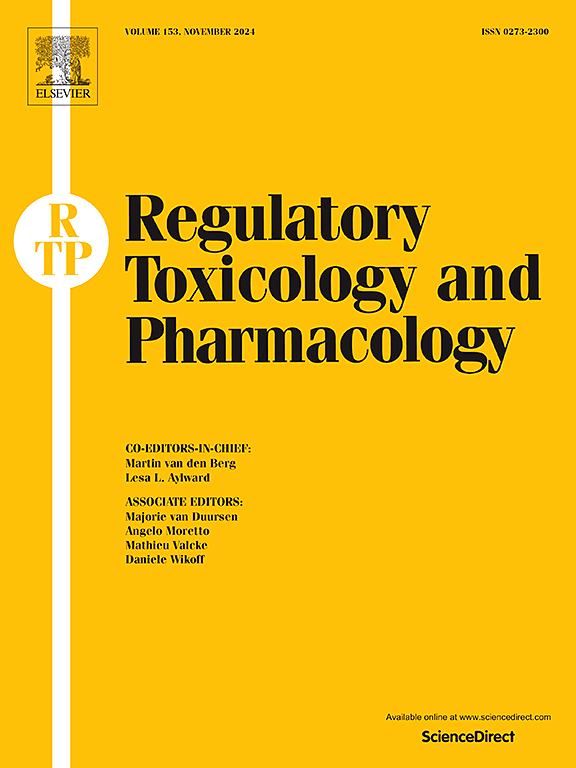Enhanced pre- and postnatal developmental toxicity (ePPND) study in non-human primates: Necessity, strategic approaches, and critical considerations
IF 3
4区 医学
Q1 MEDICINE, LEGAL
引用次数: 0
Abstract
Nonclinical developmental and reproductive toxicity (DART) studies are crucial components of novel drug development, as they identify reproductive and developmental risks and ensure drug safety in populations such as pregnant women and women of childbearing potential (WOCBP). Rodents or rabbits are commonly used in nonclinical studies to evaluate DART for chemical compounds. However, for most antibody-based biopharmaceuticals, non-human primates (NHPs) are the only pharmacologically relevant species, necessitating the use of NHPs in DART studies. These studies pose significant challenges due to stringent design requirements, complex protocols, prolonged timelines, and high costs. A single well-designed NHP study, in which the test substance is administered from gestational day 20 until delivery (enhanced Pre- and Postnatal Developmental study, ePPND study), is preferable to conducting separate Embryo-Fetal Developmental (EFD) and Pre- and Postnatal Developmental (PPND) studies. This review highlights the scientific rationale for NHP-based ePPND studies as mandated by major regulatory agencies, discusses advanced methodologies, key challenges (including endpoint selection, experimental design optimization, and data interpretation with case examples), and offers guidance for ePPND design across antibody-based therapeutics.
非人类灵长类动物的增强产前和产后发育毒性(ePPND)研究:必要性、策略方法和关键考虑。
非临床发育和生殖毒性(DART)研究是新药开发的关键组成部分,因为它们确定了生殖和发育风险,并确保孕妇和育龄妇女(WOCBP)等人群的药物安全性。啮齿类动物或兔子通常在非临床研究中用于评估化学化合物的DART。然而,对于大多数基于抗体的生物制药,非人灵长类动物(NHPs)是唯一的药理学相关物种,因此需要在DART研究中使用NHPs。由于严格的设计要求、复杂的协议、漫长的时间和高昂的成本,这些研究提出了重大挑战。一项设计良好的单一NHP研究,在该研究中,从妊娠第20天到分娩时使用测试物质(增强的产前和产后发育研究,ePPND研究),比单独进行胚胎-胎儿发育(EFD)和产前和产后发育(PPND)研究更可取。本综述强调了主要监管机构授权的基于npp的ePPND研究的科学依据,讨论了先进的方法、关键挑战(包括终点选择、实验设计优化和案例数据解释),并为基于抗体的治疗方法的ePPND设计提供了指导。
本文章由计算机程序翻译,如有差异,请以英文原文为准。
求助全文
约1分钟内获得全文
求助全文
来源期刊
CiteScore
6.70
自引率
8.80%
发文量
147
审稿时长
58 days
期刊介绍:
Regulatory Toxicology and Pharmacology publishes peer reviewed articles that involve the generation, evaluation, and interpretation of experimental animal and human data that are of direct importance and relevance for regulatory authorities with respect to toxicological and pharmacological regulations in society. All peer-reviewed articles that are published should be devoted to improve the protection of human health and environment. Reviews and discussions are welcomed that address legal and/or regulatory decisions with respect to risk assessment and management of toxicological and pharmacological compounds on a scientific basis. It addresses an international readership of scientists, risk assessors and managers, and other professionals active in the field of human and environmental health.
Types of peer-reviewed articles published:
-Original research articles of relevance for regulatory aspects covering aspects including, but not limited to:
1.Factors influencing human sensitivity
2.Exposure science related to risk assessment
3.Alternative toxicological test methods
4.Frameworks for evaluation and integration of data in regulatory evaluations
5.Harmonization across regulatory agencies
6.Read-across methods and evaluations
-Contemporary Reviews on policy related Research issues
-Letters to the Editor
-Guest Editorials (by Invitation)

 求助内容:
求助内容: 应助结果提醒方式:
应助结果提醒方式:


